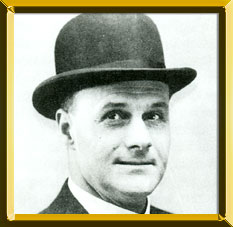
George (Tex) Rickard led boxing into the era of million-dollar gates, huge crowds and fights at Madison Square Garden. Born in Missouri in 1871, Rickard left school at age nine. In 1894, he went to Alaska and discovered gold, although he later remarked that he sold his claim for too low a price. When the Klondike gold rush started, Rickard ran a hotel in Dawson known as the Northern. He made a sizable fortune before going broke in the boom-and-bust economy. He opened another version of the Northern in Nome and stayed in Alaska for the next twelve years.
Rickard followed gold prospectors to Nevada, where he opened another hotel called the Northern, before boxing caught his fancy. Local business leaders wanted to stage a boxing match to publicize the growing community. Rickard had recently attended a boxing match in New York, so he was given the task of making the arrangements. He tried unsuccessfully to sign Terry McGovern and Jimmy Britt-the two fighters he had seen in New York, but then landed Joe Gans and Battling Nelson for $30,000. The gate receipts from the fight, held on Labor Day, 1906, were $69,715, the largest ever for a boxing match. Although Rickard was no boxing expert, he saw the earning potential of the sport. Backed by Montana mining interests, Rickard outbid James Coffroth among others for the right to promote the James J. Jeffries-Jack Johnson fight. The fight was held in Reno on July 4, 1910. Rickard helped recoup the money paid to the fighters by selling the film rights for $101,000. The fight drew 15,760 fans who paid $270,775 to see the spectacle.
Rickard believed in getting top attractions, publicizing them, and charging high prices for the tickets. When he shifted his base of operations to New York following the passage of the Walker Law which legalized boxing in the state, Rickard made successful overtures to the upper strata of society. He was also skillful in dealing with politicians to facilitate the promotion of his fights.
At the urging of Jack Dempsey's manager, Jack (Doc) Kearns, Rickard agreed to promote the Jess Willard-Dempsey championship fight in Toledo, Ohio in 1919. Although that match was not one of Rickard's most successful promotions, it set the stage for another Dempsey fight held at Boyle's Thirty Acres near Jersey City on July 2, 1921.
Rickard matched heavyweight champion Dempsey with light heavyweight champion Georges Carpentier. Although Dempsey outweighed Carpentier by about twenty pounds, Rickard raised interest in the fight to never-before-seen levels. He played on the fact that Carpentier had been a French war hero in World War I, while Dempsey had avoided military service. Dempsey won the fight easily, but the real story was the gate. More than 80,000 fans paid a record $1,789,238. Five years later in a Rickard promotion, 120,757 paid $1,895,733 to watch Gene Tunney upset Dempsey. The rematch held in Soldier Field in Chicago drew 104,943 with a gate of $2,658,660.
Rickard developed Madison Square Garden into a top boxing venue. With help from Nat Fleischer and others in site selection and financing, Rickard built a new Madison Square Garden at 49th Street and Eighth Avenue, which became known as "The House That Tex Built." The New York Rangers hockey team was named after Rickard as a wordplay on "Texas Rangers."
Rickard also helped Nat Fleischer start The Ring magazine and compiled the first annual top-ten-contender ratings for the magazine. At the time of his death on January 6, 1929, Rickard was planning on expanding his base of operations to Florida and England.
* * *
Excerpted with permission from 'The Boxing Register' by James B. Roberts and Alexander G. Skutt, copyright © 1999 by McBooks Press. All rights reserved.
Born: 1871
Died: Jan. 6, 1929
Induction: 1990
George (Tex) Rickard
